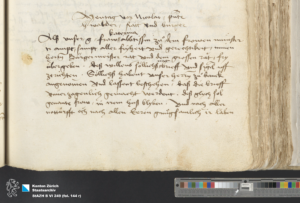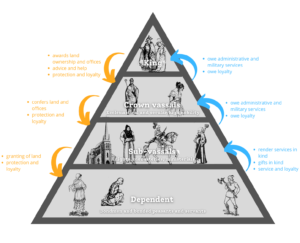Materials for Schools
Sources
Historians use the term “source” to describe all things from the past that allow us to garner knowledge of this past. These can be objects, such as chalices, coins, weapons, or pictures, that date from the time under study. While anything historical can serve as a source, the vast majority of sources are written documents of some sort.
It is important to distinguish between historical sources and secondary literature. Only historical texts (and objects) are considered sources. Modern texts that deal with historical topics, such as history books or this website, are not sources but are considered secondary literature.
«Narrative» and «Social» Sources.
Sources do not convey neutral images of the past. Therefore, it is important to first consider the type of source one is dealing with. Historians often distinguish between “narrative” sources – such as chronicles legends etc. and “social” sources, such as charters, legal documents, etc. Narrative sources are texts that were specifically composed to convey a certain image. Typical examples include chronicles, but also the lyric of courtly love, or theological treatises, etc.
Social sources include remnants that served a specific purpose in their time. Examples include private letters, shopping lists and everyday clothes, but also court records and official decrees. For a long time, historians have considered social sources more objective than narrative sources. And while this may be the case, the categorization of a source into one of these categories is not always easy, as the transitions are blurry.
Source Criticism
For historians, it is important to have as much additional information as possible about a source in order to be able to classify it and to have a sense of its epistemological limitations. The sources telling us about past cultures and societies were not written to present as neutral a picture as possible to posteriority. Rather, especially narrative sources such as chronicles were written to convey a certain image – for example of a particularly successful king, etc. Identifying the intent(s) that guided the authors of a given source is therefore a crucial part of the historian’s work.
In addition to identifying who compiled a certain document and why (intent), historians also will establish when and where a document originated (geographical and socio-political context). For example, it makes a big difference whether a text on the history of Palestine was written in Nazi Germany, in present-day Israel or in present-day Palestine. The same applies to the listing of the rights and possessions of a monastery. Do they stem from the monastery themselves and was the list compiled during a conflict? In the case of conflict, what are the precise circumstance (context and intent) did the community in question seek to defend rights that were traditionally theirs and that a third party challenged? Or did they maybe forge a document to create claims on lands that were not traditionally theirs? These are some of the typical questions historians need to answer in order to be able to evaluate a source and the information it conveys. This essential aspect of historical work is called “source criticism”
The Paths of the Past
How have texts and objects from the distant past come down to us? The short answer to this question is: selection and coincidence. It is important to be aware that only a very a small fraction of objects and documents have found their ways into modern archives and museums. And the more distant the past, the smaller the number of surviving sources.
For our knowledge of the Middle Ages, monasteries were of crucial importance, as they were particularly important places of transmission. Medieval monks and nuns copied religious, philosophical, but also literary texts in their monastic scriptoria. Monastic libraries were often comprehensive. In addition to medical books, theological and legal treatises, they housed the poetry of Ovid and the writings of Caesar. Today, we only know these texts because they were copied again and again in monasteries.
When a monastery was dissolved – during the Reformation or in the aftermaths of the European Revolutions – other institutions took over their precious libraries and archives. Since the late 18th century, these ‘other institutions’ were the newly created state and national archives. Today, archives are still the primary homes of historical documents where they are accessible to the general public. In addition to state archives and museums, private archives also house many historical artifacts and documents.
AM
Further reading:
A. v. Brandt, Werkzeug des Historikers 2013 (1958), 48-63.
Martha Howell & Walter Prevenier, From Relaibel Sources (2001), 20-24.
Foundation Charter of Notre-Dame de Soissons
French summary of the Latin foundation charter stating the abbey’s fundamental rights. The summary dates from the 18th-century inventory of Notre-Dame’s late medieval cartulary.
Copy ms. Archives départementales de l’Aisne H 1508 1506, pp. 1-3; late medieval copy fol. 34 r-35 v.



Images from: ms. Archives départementales de l’Aisne H 1508 1506, S. 1-3; spätmittelalterliche Kopie fol. 34 r-35 v.
French Original
Lettres de Drausin Evêque de Soissons,
par lesquelles a la priere d’Ebroüin
Maire du Palais du Roy Clotaire, de Leutrude sa femmes de Bovo son
fils, et de plusieurs Eveques,
Il veut que L’abaye des Relligieuses
de notre Dame dud. Soissons, Joüisse
des memes privileges, libertés et
Exemptions dont joüissoient les
Monasteres de St. Maurice,
de Lerins de Luxeüil Et de St. Marcel
de Châlons,
Qu’elles possedent paisiblement
Tout ce qui leur a esté donnée par led.
Ebroüin. Leutrude et Bovis leur fils, par
les Roys et Princes et par tous les
fidelles, sans qu’aucun Ecclesiastique,
Evêque, nj meme le Roy, puissant
rien prendre ou retrancher de ce qui leur
a esté donné et destiné pour l’usage
desd. Relligieuses.
Que quand L’abbesse Mourre
La Communauté en Elise une autre
du nombre desd. Relligieuses Laquelle
porra se faire benir par tel Evêque
que bon luy semblera et a lad. Communauté
sans povoir par led. Eveque rien Exiger
pour la Ceremonie de lad. benediction,
Que personne ne pourra Entrer
dans les Lieux Reguliers de lad. Abaye
qu’avec la permission de Madame L’abesse
et de la Communauté et pour affaires de leur salut,
que Si quelque Seculier, Entre dans lad.
abaye, jl n’y pourra, boire nj manger,
que lorsque L’Evêque seul ou avec son
Clergé y se rendroit, pour y faire des prieures ou pour y officiers, Il ne Recervoirt aucun
present desd. Dames Soit pour luy
Pour quelque Ecclesiastique ou pour
quelque Seculier,
et jl ne pourroit nj
aucun Ecclesiastique arreter dans l’abaye
sans quelque necessité Extraordinaire
a fin de ne pas troubler les Exercices
de Religion desd. Dames,
Lorsque quelque Religieuse
Commettroit quelque faute, la Correction
En appartiendroit a Madame L’abesse
Conformement a la Regle de l’ordre,
Lesd. Lettres données a Soissons
Le Sixieme des Kalendes de Juillet
L’an xi du Regne de Clotaire,
Signées
Dud. Drausin et de 18 Eveques
Translation
Document of Drausin, Bishop of Soissons, by which, at the request of Ebroin, majordomo of King Clothar III [of Neustria], and Leutrude, his wife, and Bovo, their son, and certain bishops, is confirmed that the abbey of the nuns of Notre-Dame in said Soissons enjoy the same privileges, liberties and immunities enjoyed by the monasteries of St Maurice, Lerins, Luxeuil and St Marcel of Châlon.
That they [the nuns] peacefully possess all that is given to them by the said Ebroin, Letreude and Bovis, their son, by the kings and princes and all the faithful, and that no ecclesiastic, bishop, not even the king, is allowed to take or withdraw anything from it.
That, when the abbess dies, the community elects another from amidst the community of nuns. This [abbess elect] will be consecrated by the bishop of her and the community’s choosing, without the said bishop demanding any payment for the said consecration ceremony.
That no one may enter the monastic precincts of the said abbey except with the consent of the abbess and the community, and [only] for reasons pertaining to their salvation.
That if any secular person enters the said abbey, they may neither drink nor eat there.
That if the bishop is there alone or with his clergy to pray or celebrate mass, he shall not [be entitled to any] gifts from said ladies, either for himself, for other churchmen, or for any secular.
Nor may any churchman stay [longer] at the abbey without special cause so as not to disturb the nuns’ exercise of religion.
If any nun should commit a fault, the abbess has the right to punish her according to the rules of the order.
This deed was given at Soissons, on the 6th Kalends of July in the eleventh year of Clothar’s reign [16 June 668].
Signed:
The said Drausin and 18 bishops
Confirmation of Notre-Dame’s Patrimony
Confirmation was issued by Charles the Bald in Compiegne in 858.
The 18th– century copyist uses the past tense throughout, since many of the possessions mentioned in the confirmation were no longer owned by Notre-Dame in the 18th century.
N.B. That the supposedly German place names are transcribed but not translated.
Copy from Archives départementales de l’Aisne 1508 , pp. 3-6; fol. 33r-34r.

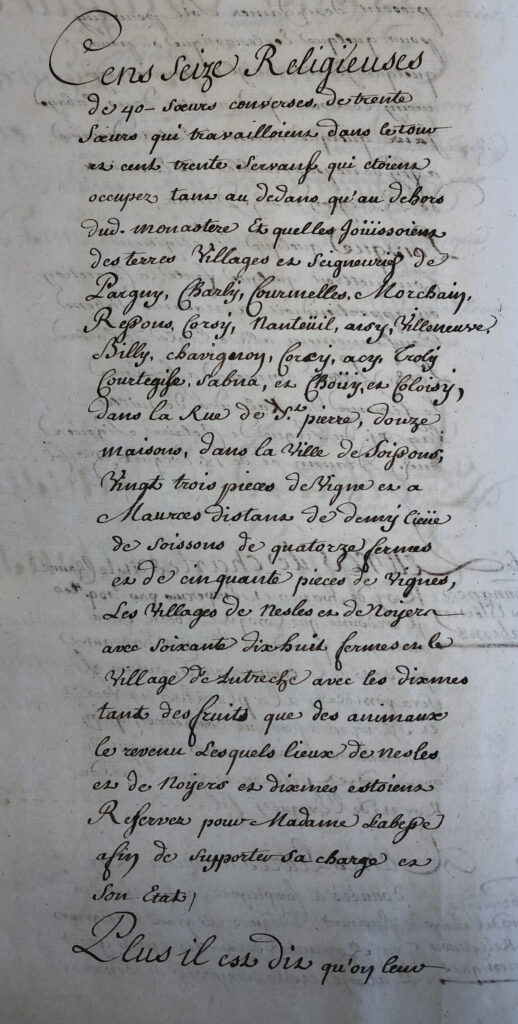
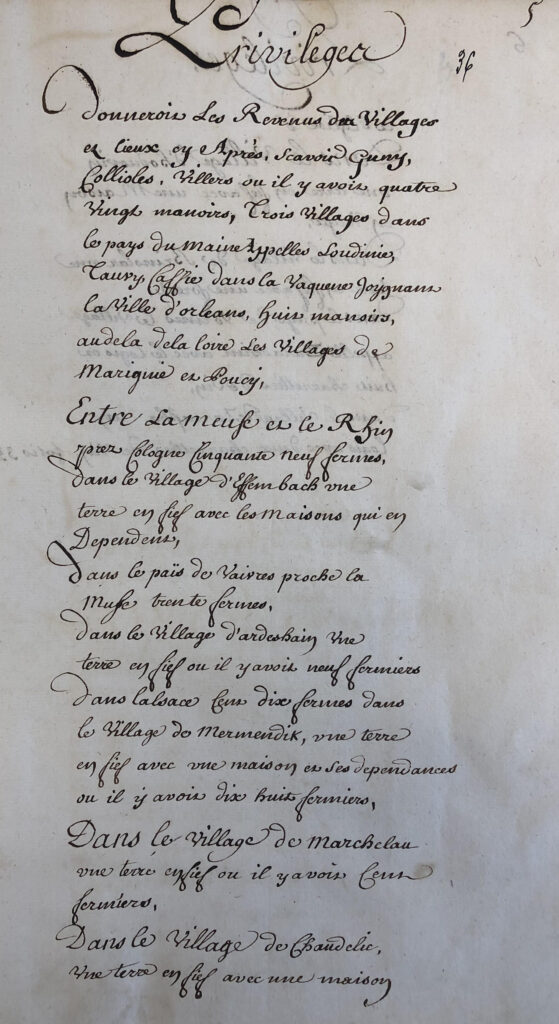
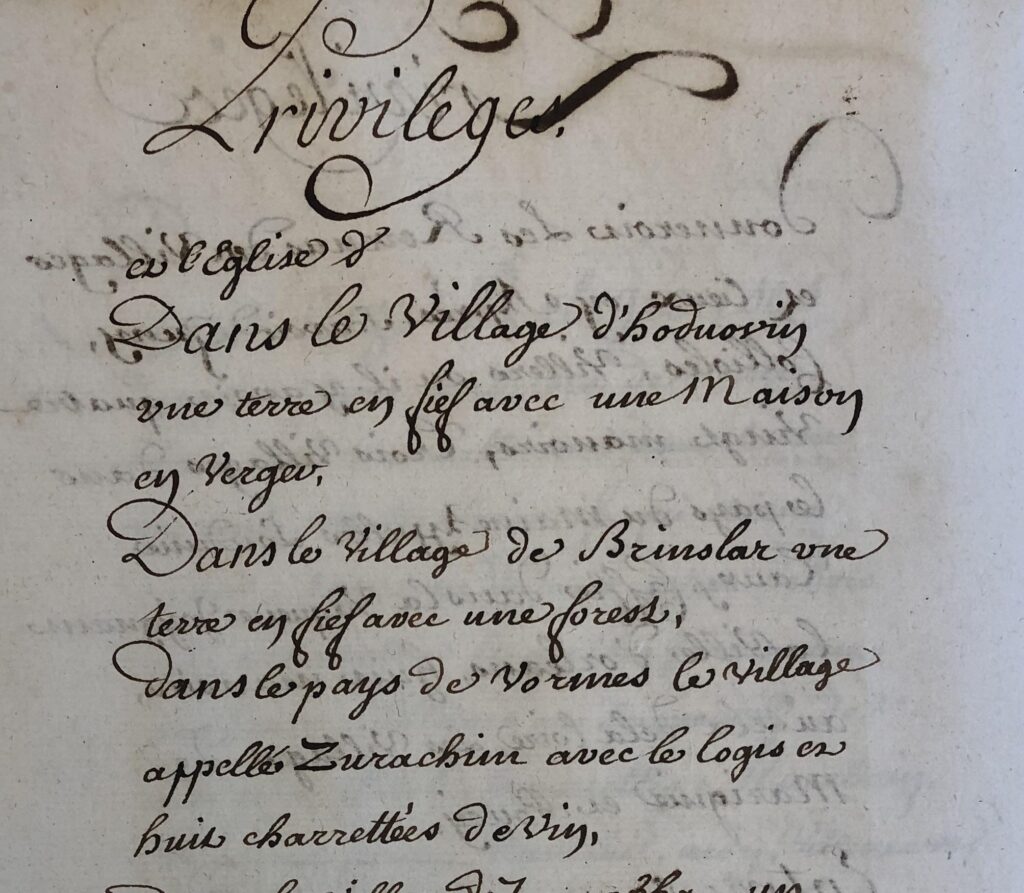
Images from: Archives départementales de l’Aisne 1508 , S. 3-6; fol. 33r-34r.
French Original
Autres Lettres du meme Roy
Données a Compiegne confirmées par
Plusieurs Evêques et grand Seigneurs
Du Royaume, desquelles apert (?) que
L’abaye etoit composée de deux
Cens seize Religieuses
De 40 – soeur converses, de trente
Soeurs qui travailloient dans le tout
Et cent trente Servans qui etoient
Occupez tant qu dedans qu’au dehors
Dud. Monastere
Et qu’elles Joüissoient des terres Villages et Seigneuries de Pargny, Charly, Courmelles, Morchain, Ressons, Corsy, Nanteüil, aisy, Villeneuve, Billy, Chavirnon, Corcy, Acy, Troly, Courtegise, Sabna, et Choüy, et Coloisy,
Dans Rue de S.t pierre, douze maisons, dans la ville de Soissons, Vingt trois pieces de Vigne
et a Maurces distant de demy lieüe de Soissons de quatorze fermes Et de cinquante piece de Vignes,
Les Villages de Nesles et de Noyers avec soixante dixhuit fermes en le Village d’Autreche avec les dixmes tant des fruits que des animaux le revenu Lesquels lieux de Nesles et de Noyers et dixmes estoient reservez pour Madame Labesse
Afin de supporter sa charge et Son Etat.
Plus it est dit qu’on leur Donneroit Les Revenus des Villages et lieux cy Après, scavoir Guny, Collioles, Villers ou il y avoit quatree vingt manoirs, Trois Villages dans les pays du Maine Appelles Loudine, Taury, Caffie dans la Vaquene Joygnant la Ville d’Orleans, huit mano irs, Au dela dela (sic) loire
Les villages de Marignie et Poucy, Entre La Meusee et le Rhin Prez Cologne Cinquante neuf femes, Dans le Village d’Eggembach une Terre en fief avec les maisons qui en Dependent, dans le païs de Vaivres proche la Muse (sic) trente fermes, dans le Village d’Ardeshain Une
terre en fief ou il y avoit neuf fermiers
dans l’alsace cent dix fermes dans le Village de Mermendik, une terre en fief avec une maison et ses depednances ou il y avoit dix huit fermiers,
Dans le village de Marchelau une terre en fief ou il y avoit cent fremiers, Dans le Village de Chaudelic, une terre en fief avec une maison et l’Eglise Dans le Village d’hoduovin (?) une terre en fief avec une Maison en verger,
Dans le village de Brinslar une terre en fief avec une forest, dans le pays de Vorms le village appellée Zurachim avec le logis et huit charrettées de vin, Dans le village de Zarnpha un Logis avec deux charrettées de vin
Translation
Another charter by the same king, issued at Compiegne and confirmed by several bishops and great men of the kingdom, stating that:
The abbey comprised 216 nuns: [namely] 40 cloister nuns, 30 sisters working throughout the precincts, and 140 servants employed both within and without the said monastery.
And that they [the nuns] possessed the lands, villages, and seigneuries of:
Pargny, Charly, Courmelles, Morchain, Ressons, Corsy, Nanteüil, Aisy, Villeneuve, Billy, Chavirnon, Corcy, Acy, Troly, Courtegise, Sabna, et Choüy, et Coloisy,
[and] in the town of Soissons, in the Rue St. Pierre: 12 houses, [along with] 23 pieces of vineyard.
And in Maurces, situated half a lieu (c. 2 km) from Soissons [they owned] 14 farms and 50 vineyard;
[They also owned] the villages of Nesles and Noyers, 78 farms in the village of Autreche together with the tithes of both crops and animals.
The revenues of these villages of Nesle and Noyers together with their tithes were reserved for the abbess for her own maintenance and that of her court.
Furthermore, [the charter of Charles the Bald] states that the nuns were given the cens of the following villages and places, namely: Guny, Collioles, Villers with 80 manors; three places in the country of Maine called Loudine, Taury, Caffie; in la Vaquene next to the city of Orléans beyond the Loire: eight manors.
Between the Moselle and the Rhine rivers: the villages of Marignie and Poucy; near Cologne: 59 farms, in the village of Eggembach: one land as a fief with the houses belonging to it; in the country of the Vaivres near the Moselle river: 30 farms; in the village of Ardeshain: one land as a fief with 9 serfs;
In Alsace: 110 farms; in the village of Mermendi: one land in fief with one house and associated buildings with 18 serfs.
In the village of Marchelau: one land in fief with 100 serfs; in the village of Chaudelic: a land in fief with a house and the church; in the village of Hoduovin: (?) a land in fief with a house and an orchard.
In the village of Brinslar: a land in fief with a forest; in the land of Worms: a village called Zurachim with a house and 8 carts of wine; in the village of Zarnpha: a dwelling with 2 carts of wine.
The Abbatial Oath of Klara von Montfort
German document from the Abbey of Buchau dated 31 January 1427, containing the 16 articles of the newly elected abbess of Buchau, Klara von Montfort (1426-1449).
Upon election, the new abbess had to take an oath to respect and abide by these 16 articles. It was a sort of constitution which clearly regulated abbatial authority and her relationship with the chapter. At Buchau (and in most other monasteries), abbatial rule was not absolute but required the chapter’s consent in important decisions.
Staatsarchiv Sigmaringen Dep. 30/14 T 1 Nr. 154.
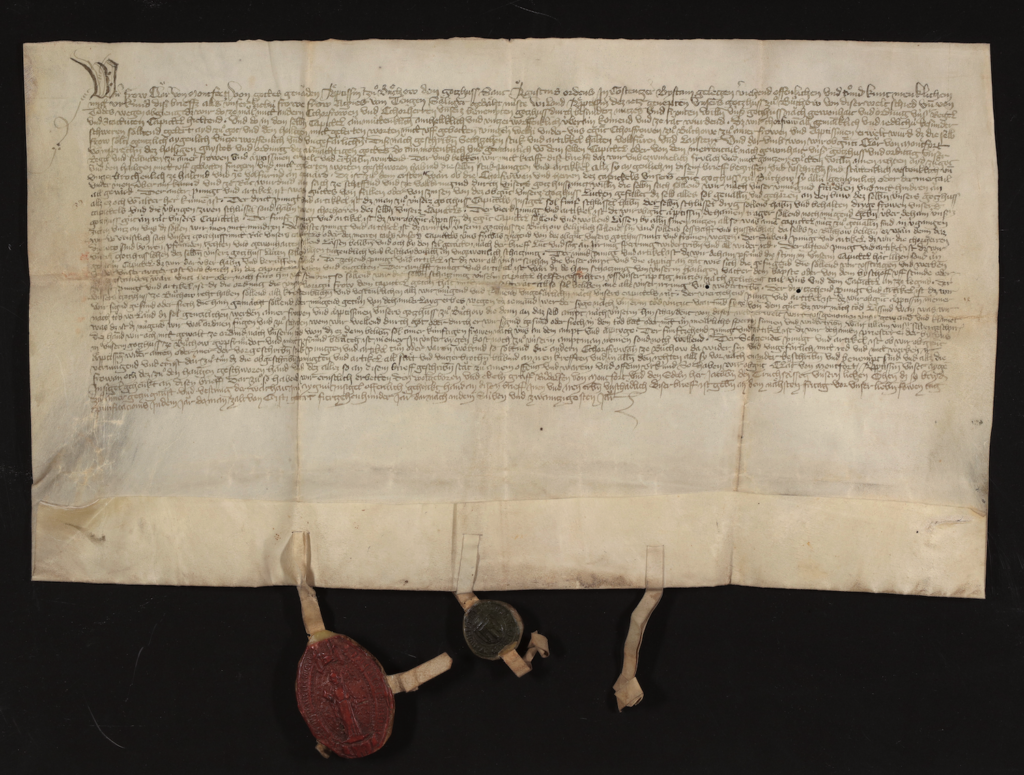
Document of Abbess Clare of Montfort. © Landesarchiv Baden-Württemberg, Staatsarchiv Sigmaringen Dep. 30/14 T 1 Nr. 154.
German original
Wir, Frow Clär von Montfortt, von Gottes Gnaden Äpptissin tzu Buchow, dem Gotzhuss Sant Agustens Ordens, in Costentzer Bystum gelegen, verkunhend offentlichen und tund kunt menklichenn mitt Urkund dis Brieffs:
Alls unser liebenn Frow, Frow Agnes von Tengen, säliger Gedächtnisse wiland, Äpptissin der ietz genantenn unsers Gotzhuss zu Buchow, von diser Welt schied und von Todes wegen abganen, dz wir do ze mal mit andern Chorfrowen und Chorherren unsers benempten Gotzhuss, durch besunderz Nutzes und fromen Willn, uns Gotzhuss nach Gewonhait und Ordnung unser Regel und Stattuten Capitel haltend.
Und do in dem selben Capitel eimmuttenklich, ainhellklich und untzerworffenklich uberein komend und ze rät wurdend, dz wir Chorfrowen all gemeinklich und redlichen besunder schweren sölltend gelert Ayd zu Got und den Hailgen mitt gelerten Worten und uff gebotten Dingen wehli under uns egenannten Chorfrowen zu Buchow zu ainer Frowen und Apptissinen erwelt wurd, dz dieselb Frow sölti gentzlich, aygenlich, untzerworffenlich und ungefärlichen daz nach geschribn Sechtzehen stuk und Artikkel halten, vollfüren und leysten. Und darumb won wir obgenannte Clär von Montfort vonnsprechen dez heiligen Gaystes und Ordung dez almächtigen Gottes do ainmötenklich und gemanlich von dem selben Capitel oder von dem Merrentail nach Gewonhait unser Gotzhuss und Ordnung unser Regel und Statutten zu ainer Frowen und Äpptissinen erwelt und erhaben wurdend.
Darumb bekken wir mit Krafft dis Brieffs, daz wir unbezwinclich, frylich und mit gantzen gutten Willn aynen rehten Ayd zu Got und den Hailgen, mitt uff gebotten fingern und mitt gelerten worten geschworen habend dieselbn stuck Pungten und Artikkel alls sy aygenlichen disenn Brieff begriffen und verschriben sind stärknklich, vestenklich unnd unzerbrochenlich ze haltend und ze volfürend, in gewärs.
- Dz ist zu dem Ersten, wan ob die Chorfrowen und -heren dez Capittels unsers egenannten Gotzhuss zu Buchau, sy alln gemeinlich oder der Mertail under inen uberainkomed und ze Rät wurdend, an Sach ze schaffend und ze vollbringend durch unsers Gotzhuss Nutz willen, die selben Sach sollend wir nach unser vermigend furdern und nitt hindren on all gevärd.
- Der ander Pungt und Artikel ist was Guttes von Fällen oder von Zinsen von dez Obgut unsers Gotzhuss Lutten gefallet, dz selb alles sol gevalln und gehören an den Buw des selben unsers Gotzhuss, allz ez och von alter her kummennt.
- Der dritt Pungt und Artikkel ist dz man zu unserz Gotzhuss Capittel Insigel sol funf Schlüssel haben. Der selben Schlüssel dryn sollend haben und behalten dryge Frowen unsers Capittels und die ubrigen zwen Schlüssel sond haben zwen Chorherren dez selbn unserz Capittels.
- Der vierd Pungt und Artikel ist, dz zur obgenannte Äptissin dehannen trager sollend noch mugend geben uber dehann uns Gotzhuss Gut on Rät unsers Capitels.
- Der fünft Pungt und Artikel ist, dz wir obgenannte Äpptissin dz egenannte Capittel söllend und wöllend lassen by alln sinen Nutzen, allso was amme Capittel Nutz zu gevallen sind in vergangen Zitten untz an uns, dz sollen wir inen nit mindren.
- Der sechste Pungt und Artikel ist, dz wir by unserm Gotzhuss ze Buchow beliplich söllend sin und söllend sesshafft und husshältlich da selb ze Buchow belibn, ez wär denn, daz wir von ernstlich Sach unsers Gotzhuss mit Rät unsers Capitels oder dez merren Tails unsers Capittels uns furbas zugend von dez obgenannten unsers Gotzhuss Nutz und fromen Wegen.
- Der subent Pungt und Artikel, dz wir die Chorherren die ietzo sind by iren Pfrunden, Rehten und Gewonhaiten sollend lässen beliben und och by den Selgerätten nach der Brieff lut und sag on Irrung, Sperrung, Widertribn und all Widerred.
- Der achtend Pungt und Artikel ist, dz wir unserz Gotzhuss Lehen des selben unserz Gotzhuss Luten soll odlichen tugendlich und beschaydenlich on ungewonlich schatzung.
- Der nund Pungt und Artikel ist, dz wir chain Pfrund die Stym in unserm Capittel hat lihen sond ain [Textverlust] Capittel, dz wir daruber habn und beruffen sulend.
- Daz zehend Pungt und Artikel ist, dz wir all unser Sachen die unser Ampt und die Apptig an Gut, wie sich die gefügend, die söllend wir usstragen und werben [Textverlust] unser ayger cost und brach an daz Capitel Schaden und Engelten.
- Der aynlfft Pungt und Artikel ist, wär dz de kain Schatzung von unserm hailigen Vatter dem Bäpste oder von dem Byschoff uff stunde oder [Textverlust] standen wär untz her oder noch füro hin uff stundent, so sollend wir die selben Schatzung unserm Capittel helfen uffrichten, uff unser Aptig Nutzen nach gelichenn Tail uns und dem Capittel antzlegend.
- Der zwelft Pungt und Artikel ist, dz die Ordnung die unser vorigen Frow dem Capittel getan hät im [Textverlust] solt wär allso sol beliben one alle unser Irrung und Widertribn.
- Der drytzehend Pungt und Artikel ist, dz wir unsers Gotzhuss ze Buchow Reht haben söllend, allz kreftenblichen und vestenklichen allz wir migend und kunend, ungefärlichen näch unsers Capittels Rät.
- Der viertzehend Pungt und Artikel ist, dz wir obgenannte Äpptissin niemer wir siynd Gesund oder Siech die hann gemächt söllend oder mugend getun von dehamlerlayg Erbes wegen, dz iemannd wer der fyge näch unserm Töd […] fyge von dem Gut, dz wir nach tod lässend, wan was wir nach Tod verkänd, dz sol gentzlichen werden ainer Frowen und Äpptissinen unsers Gotzhuss zu Buchow, die denn an daz selb Ampt nach unserm Hinschayden von diser Welt erwelt wirt. Ussgenomen unser Gewand und Klainot, was dz ist dz mugend wir wol ordnen fügen und zu schyben wem wir wellend, durch Got oder durch er-, wir siynd Gesund oder Siech in dem Tod Bett oder mitt on merklichs sperren Sinnen und undertriben wirf all on unser Silbergeschirr, dez händ wir och mit gewalt ze ordned, näch unserm Töd wan dz ez dem beliben sol einer kunftigen Frowen nach uns in dem Ampt und Apptyge.
- Der funftzehend Pungt und Artikel ist dz wir dekainen Priestere, der by uns in unserm Gotzhuss ze Buchow gepfrundot und mitt pfrund beräten ist, niemer in unser aygen Kost noch zu unserm Amptman nemen sond noch wellend.
- Der sehtzendt Pungt und Artikel ist, ob wir obgenannt Äpttissin wider ainen oder mer der vorgeschriben stuk Pungten und Artikel tun oder varen wöltend, so söltend die andern Chorfrowen ze Buchow da wider sin und ungefärlich mit Red und mitt Werken in Vermugend und Ernst dartzu tun, dz die obgeschriben Pungten und Artikel all stät und ungerbrochen blibend an iren Krefften und in alln den Rehten allz sy vor Räth enander beschribn und benempt sind.
Und allz die Insigel gehenkt an disen Brieff, dar zu so habend wir ernstlich erbeten den wolgeboren und edeln Graff Rudolfen von Montfort und den edeln Her Jacoben den Truchsässen, unsern lieben Ohen, dz sy bayd zu ainer Getzugnust und Vestung der Warhait irn aygn Insigel offenlich gehenkt hand an disen Brieff, inen und iren Erben unschädlich.
Diser Brieff ist geben an dem nächsten Fritag vor unser lieben Frowen Tag Purificationis in dem Jar do man zalt von Christ Geburt fiertzehenhunder Jar darnach in dem süben und zwantzigesten Jar.
Translation
I, Lady Klara von Montfort, by the grace of God, abbess of Buchau of the Church of St. Augustine, located in the diocese of Constance, publicly proclaim and make known to all with this letter:
When the last abbess, Agnes of Tengen, died, I held a chapter meeting with the other canonesses and canons of Buchau.
At this chapter meeting, we unanimously decided that whoever would be elected abbess, she should take an oath to God and the Saints on 16 articles. This I must do, since I have been elected abbess.
Therefore, by the power of this letter, I confess that I have voluntarily and with good will sworn an oath to God and the Saints to strengthen, keep, and act according to the articles as they are written in this letter:
- If the canons of the chapter decide to do something for the benefit of Buchau then the abbess shall promote this and not prevent it.
- As is customary, the income received from the fees and interests on the property of Buchau is to be used for the upkeep of Buchau.
- The five keys for the chapter seal are to be kept (separately) by three choir women and two canons of the chapter.
- The abbess may not award any fiefs without the advice of the chapter.
- The abbess shall leave all benefits the chapter has hitherto enjoyed untouched.
- The abbess shall reside in Buchau and shall only leave Buchau on the chapter’s request on account of matters concerning the abbey.
- The prebends, rights and customs of the canons are to remain untouched by the abbess.
- The abbess shall grant the abbey’s fiefs to the abbey’s people in an orderly manner.
- When a seat in chapter vacates, the abbess may not appoint a new member without the consent of the chapter.
- All matters pertaining to the abbacy and the abbey shall be settled by the abbess at her own expense without additional cost to the chapter.
- Papal and episcopal treasuries (taxes) shall be paid for jointly by the abbey and the chapter.
- The regulations and decisions of the previous abbess shall remain unaltered.
- The abbey’s prerogatives are to be preserved and the advice of the chapter always be considered in matters pertaining to them.
- Everything the abbess owns is to be bestowed on the future abbess after the former’s death. Excepted from this is her vestments and jewels, which she may decide herself to whom she bequeaths them.
- The abbess may not appoint a priest who is paid by Buchau to her own board or as her bailiff.
- If the abbess violates these articles, the other canonesses of Buchau shall prevent this by word and deed.
When the seals were added to this letter, I asked the highborn and noble Count Rudolf of Montfort and the noble Lord Jacob, my dear uncle, to also add their own seals to the letter, without any harm to them or to their heirs, as testimony and for the consolidation of the truth.
This letter was written on Friday before Candlemas in the year 1427 of Christ’s birth. (31 January 1427).
The Founding Charter of Fraumünster Abbey
Charter issued by Louis the German (c. 806-876), dated 21 July 853.
Louis transferred a number of his possessions in the area of Zurich to Fraumünster and appoints his daughter, Hildegard, abbess.
Staatsarchiv Zürich. Printed in: Wyss, G. von, Geschichte der Abtei Zürich. Beilagen; Urkunden nebst Siegeltafeln, Zürich 1851/58.
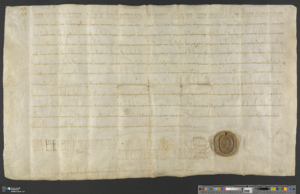
Latin Original
In nomine sanctae et individuae trinitatis. Hludovicus divina facentente gratia rex. Si de rebus terrenis quas divina sumus largitate consecuti ad loca sanctorum ob divinum amorem regium morem decenter implentes aliquid conferimus hoc nobis esse profuturum ad aeternae remunerationis praemia capessenda liquido credimus.
Quapropter conperiat omnium fidelium sanctae dei ecclesie nostrorumque praesentium scilicet et futuroum industria qualiter nos pro serenissimi imperatoris avi nostri karoli et praestantissimi hludouvici augusti domni ac genitoris nostri. nec non et nostra sempiterna remuneratione. ac pro coniugis prolisque nostrae carissimae perpetua mercede curtim nostram turegum in ducatu Alamannico in pago durgaugense cum omnibus adiacentiis vel aspicientiis eius seu in diversis functionibus id est pagellum uroniae. cum ecclesiis domibus ceterisque aedificiis desuper positis. mancipiis utriusque sexus et aetatis. terris cultis. et incultis silvis. pratis. pascuis. aquis. aquarumve decursibus adiacentiis perviis exitibus et regressibus. quaesitis et inquirendis cum universis censibus. et diversis redibitionibus insuper etiam forestum nostrum albis nomine et quicquid in eisdem locis nostri iuris atque possessionis in re proprietatis est et ad nostrum opus instanti tempore pertinere videtur totum et integrum ad monasterium nostrum tradimus quod situm est in eodem vico turegum ubi sanctus felix et sancta regula martyres Christi corpore quiescunt.
Quod videlicet eo rationis tenore conplacuit nobis agendum ut deinceps in posterum ibidem omni tempore sanctimonialium feminarum sub regulari norma degentium vita conversatioque monasterialis monachicho cultu instituta celevretur et libentius propter huius loci supplementum a nobis iam praedictis martyribus dediti dei famulatus illic exhibeatur ac pro nostrae debitorumque nostrorum omnium mercedis augmento diligentius domini misericordia et uberius exoretur.
Volumus etiam ut fidelium nostrorum noverit benivolentia quod paterna pietate commoniti supradictum monasterium cum omni integriate unacum nostra traditione in locis praefatis dilectissimae filiae nostrae hildigardae in proprietatem concessiumus ut quatum domino permittente valeat familiam in eodem monasterio domino militantem suoque dominatui subiectam disciplinis regularibus et observantiae monasterialis institutione corrigat et nutriat locaque ipsa sibimet concessa quantum vires suppeditent profectibus et emendationibus augmentando provehat et emendet.
Denique iubentes praecipimus ut nullus iudex publicus nec comes vel quislibet et iudiciaria potestate in locis praefatis vel in cunctis rebus ad eandem loca respicientibus seu homines tam liberos quam et servos qui illic commanere videntur distringere aut infestare nec fideiussores tollendos aut ullas redibitiones vel freda aut bannos exigendo aut alicuius iniuriae vim ullo umquam tempore inferre praesumat sed sub nostra defensione et munitatis tuitione cum advocatis ibi constitutis res illae secure per diuturna tempora permaneant.
Et ut haec auctoritas donationis atque confirmationis nostrae firmior habeatur et per futura tempora a cunctis fidelibus sanctae dei ecclesia nostrisque praesentibus et futuris verius credatur atque diligentius conservetur manu propria nostra subter eam firmavimus et anuli nostri inpressione adsignari iussimus.
Signum domni hludovici gloriosissimi regis.
Comeatus notarius ad vicem radleici recognovi et (L.S.)
Data XII. kld. augt. anno Christo propitio XX. regni domni hludouvici serenissimi regis in orientali francia Indictione prima. actum reganesburg civitate in dei nomine feliciter, amen.
Translation
In the name of the Holy and Indivisible Trinity, Louis, by the grace of God, king: when, through divine goodness, we donate from the earthly things that have come to us to the places of the saints, out of love for God and to fulfil the royal custom, we clearly believe that this is useful for us to obtain the reward of eternal salvation.
Therefore, by the zeal of all, of God’s holy Church and of us faithful, present and future, for the salvation of the soul of the most august Emperor, of our ancestor Charles, and of Louis, our exalted lord and father, as well as of ourselves, also for the sake of the eternal reward of our most beloved spouse and children, let it be known:
That our court [possessions] of Zurich, situated in the Duchy of Alemannia, in the Land of Thurgau – with all that lies within it, or belongs to it, or otherwise depends on it – be given wholly and completely to our monastery, which is also situated in the district of Zurich, where rest the relics of Saint Felix and Saint Regula, the blood witnesses of Christ [= martyrs]. This includes the small country of Uri, with churches, houses and other buildings standing on it, with people of all sexes and ages, with cultivated and uncultivated land, with forests, meadows and pastures, with standing and flowing waters, paths, exits and entrances, with what has been acquired or is to be acquired, with all tithes and various fees. Moreover, also our forest, which is called Albis, and everything that is in those places in our right and possession and our own and currently belongs to us.
It pleases us to decide that from now on and in the future, the life of [Fraumünster’s] nun’s will be cultivated there at all times in monastic community according to the rule, structured according to monastic custom. And that for the sake of the endowment, which we have bestowed upon this place [and] which we dedicate to the aforementioned blood witnesses [= the martyrs St. Felix and St. Regula], God will have mercy and render a merciful judgement on us.
We also want all our faithful to know that we, moved by fatherly love, have left the aforementioned monastery with all that belongs to it, and with our donations of the aforementioned places to our most beloved daughter Hildegard. So that she may, as much as she can, with God’s grace, keep the [monastic] family which serves God in the aforementioned monastery and [which] is subject to her rule, to practice the rule and to observe monastic discipline, to nourish them and to increase and improve places given to her.
Finally, we order and decree that no public magistrate, nor count, nor anyone of judicial authority may challenge, interfere with or demand tithes from the aforementioned places and all that belongs to them, or demand any services or fines and money from them, or ever do any unlawful violence to them; but that all this may remain under our protection exercised through the bailiffs who are sent there, for all eternity.
So that this testimony of our donation and assurance may be kept now and in future times and carefully preserved by all – the holy Church of God and our faithful, present and future – we have certified it with our own hand and ordered it to be marked with the imprint of our signet ring.
The sign of the most glorious Lord and King Louis.
Issued on the 12th day before the beginning of August. Under Christ’s grace in the twentieth year of the reign of the most illustrious Lord and King in East Franconia, Louis. Issued in the city of Regensburg. In the name of God, who is gracious to us, Amen.
Transferal of Fraumünster Abbey to the City of Zurich
Katharina von Zimmern transfers all rights and possessions of Fraumünstere Abbey to the mayor and city council of Zurich on 5 December 1524.
German Original
Mentag vor Nicolai, put. herr Walder, Rätt und burger.
Alss unser g(nedige) fraw Katerina abbtissin zu dem frowen münster ir ampt, sampt aller fryheit und gerechtikeit, minen herrn Bürgermeister rat und dem grossen rat, fry übergeben.
Dess willens söllichs mit brieff und sigel uff zerichten. Söllichss habent unser herrn zu dank angenommen und lassent beschehen, dass die brieff unverzogenlich gemacht werdent. des glych sol genante fraw, in irem huss blyben. Und nach aller nottürfft och nach allen Eeren genügsamlich ir läben lang versähen werden.
Der ämpter halb, lasst man Schultheiss epfinger, dess glychen den amman fryen, by iren ämptern blyben. der andern ämpter halb, war man villicht hinfür nit mer notturfft sin.
Translation
Monday before Nicholas (5.12.1524), Lord Walter, representative of the council and citizens [of Zurich].
Our gracious lady, Katharina of Zimmern, Abbess of Fraumünster, has freely surrendered her office with all liberties and rights to the Lord Mayor and Council [of Zurich] as well as to the Great Council [of Zurich].
This must be confirmed with letter and seal. The lords have accepted this with thanks and order that this be done without delay. Katharina of Zimmern is to be allowed to continue to live in her [accustomed] house with everything she needs there, and she is allowed to benefit from all honors and titles for the rest of her life.
The offices of Schultheiss [lay executive officer of the abbess] and also of Ammann [lay administrator of the abbess] shall remain occupied. The other offices may no longer be needed.
The Letter from Regula Keller
Letter of Regula Keller (1497-1573), a nun from the convent of St. Katharina in St. Gall.
Regula was the convent’s book mistress, a sort of head librarian. In the wake of her community’s dissolution during the Reformation, Regula saved numerous manuscripts by sending them to nunneries located in region unaffected by the Reformation.
St. Gallen, Stiftsbibliothek, Cod. Sang. 991, S. 2.
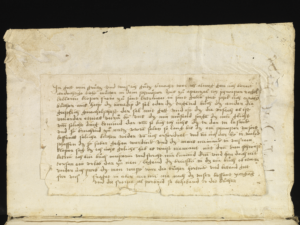
German Original
In gott min grutz und was ich gutz vermocht wer ich alweg gen üch bereit andechtige liebe mutter in dem schwoster hus zu apenzel.
Ich schwester Regel Kellerin kloster fraw zu sant katrinen in sant gallen stat, schik üch tzwey bücher, eins heist dz baradis der sel oder dz tugend buch dz ander die geistlich gmachelschaft der sel mit gott und ist dz die ursach:
es ist umerdar etwas unru by uns dz mir müsend sorgen dz wir glicht umb soliche ding komind darum so lich ich uchs dz ir darin lesind und sy bruchind zu nutz unsren selen so lang bis daz ein schwester unsers koffent soliche bücher wider von uch erfordret.
und bit üch daz by ir weled schaffen dz sy suber gehan werdind und dz mans niemand in unsrem kloster sag dz ich uchs gelichen hab es weis niemant nut drum den schwester katrin ich bin buch meisterin und furcht mir kumend dazu und han doch nit torfen ein urlob darzu nen.
legend dz brieffly in dz ein buch ob etwar under uch sturb dz man wussty war die bücher hortind und bittend gott fur uns. fraget in aber niemand me nach dz unser koffent zergieng und die frowen all sturbind so behebend ir die bücher.
Translation
God be with you and know that what good I could do for you I would do at any time, dear Mother of our sister house in Appenzell.
I, sister Regula Keller, nun at St. Katharina, located in the city of St. Gall, am sending you two books. One of them is called „Paradise of the Soul“or the „Book of Virtues“, the other one is called „The Spiritual Marriage of the Soul with God“. And this is the reason for sending them:
There is such constant unrest here that we must fear losing these things. That is why I give them to your convent so that you can read them and use them for the benefit of your souls until a sister of our convent may demand these books from you again.
And I beg you to keep them clean and to tell no one in our convent that I have sent them to you. No one here knows about it except sister Katrin. I am only the book mistress and have not asked [the prioress’] permission [to send them].
Put this letter in one of the books, so that if you should perish it may be known where the books belonged. And pray to God for us, but ask for no more. For if our convent should perish and all the women die, you will still have these books.
